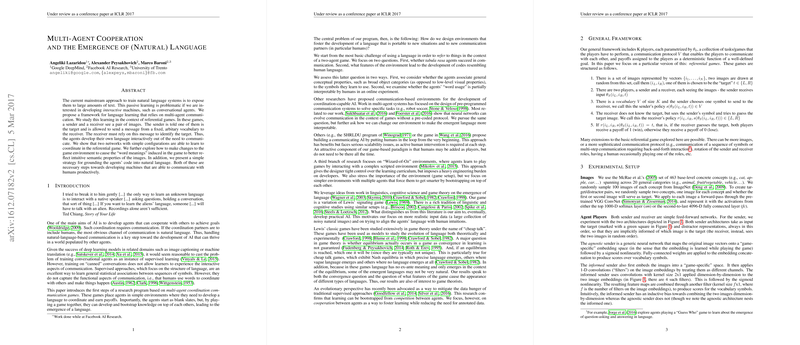Multi-Agent Cooperation and the Emergence of (Natural) Language
The paper "Multi-Agent Cooperation and the Emergence of (Natural) Language" presents an innovative approach to language learning for AI systems that deviates from traditional passive learning methodologies. Specifically, it emphasizes the adoption of an interactive learning framework predicated on multi-agent communication within referential games. In these games, language emerges organically as agents are required to communicate to identify target images among distractors. This framework provides an insightful exploration of how language elements can develop from scratch within an AI ecosystem, offering potential pathways toward enhancing AI-human interaction capabilities.
The primary objective of the research is to assess whether agents can develop a communication protocol that mirrors natural language characteristics by mere necessity of cooperation. The agents, structured as simple neural networks, are tasked to perform a referential game where the sender and receiver jointly work to identify target images from a set. Notably, this investigation also addresses how alterations in the game environment and communication constraints impact the semantic qualities of the emergent language.
Key Findings
- Agent Cooperation: The paper demonstrates that agents can effectively learn to coordinate within a reasonably short training period. The informed sender, equipped with additional convolutional layers, was shown to achieve higher coordination success more rapidly than its agnostic counterpart.
- Symbol Assignment: The emergent symbol usage often reflects conceptual rather than purely visual properties, suggesting a tendency toward developing higher-level semantic characteristics. The agents developed a set of symbols that align with general conceptual categories, evidenced by symbol usage that correlates with semantic intuitions of certain object categories.
- Environmental Impact on Language Semantics: By introducing variations in the environment, such as removing low-level visual details, the agents' communication was nudged towards more semantically rich symbols, increasing the interpretability and coherence of their language.
- Grounding Communication in Human Language: In integrating supervised learning tasks where the sender is trained on particular image-label associations, the emergent communication protocol aligns more closely with human-understandable labels. This integration significantly enhanced the interpretability of the language, enabling agents to communicate in a form relatable to natural human language despite different image sets.
Implications and Future Directions
The implications of this paper's results are multifaceted. Practically, it suggests that developing AI models capable of inventing their own communication protocols can lead to systems that interact fluidly and intuitively with humans, extending beyond rote responses derived from fixed datasets. Theoretically, the findings contribute to the understanding of language emergence, providing evidence that grounding and environmental constraints can effectively guide agents toward human-like language semantics.
Looking forward, this research paves the way for advanced conversational agents that can dynamically adapt and refine their communicative abilities through interaction, mirroring human social learning processes. Future development could involve more intricate game setups enabling even richer forms of language, including syntactical structures or language styles. The pursuit of incorporating effective predictive learning mechanisms alongside interactive experiences could further refine the balance between understanding linguistic structure and function, fostering AI systems that genuinely participate in nuanced human dialogues.
This research and its findings underscore the profound potential of leveraging interactive multi-agent frameworks to advance AI language capabilities within both theoretical exploration and practical application domains.
